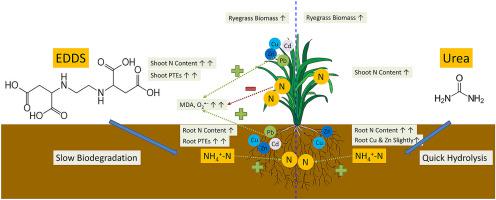Environmental Pollution ( IF 7.6 ) Pub Date : 2020-09-24 , DOI: 10.1016/j.envpol.2020.115719 Jingzi Beiyuan , Linchuan Fang , Hansong Chen , Mengdi Li , Dongdong Liu , Yunqiang Wang

|
(S,S)-ethylenediaminedisuccinic acid (EDDS) has a strong capacity to mobilize potentially toxic elements (PTEs) in phytoextraction. It can release NH4+-N via biodegradation, which can enhance N supply to soil thereafter promote plant growth and plant resistance to PTEs. However, the advanced feature of released N in the EDDS-enhanced phytoextraction remains unclear. In the current study, the effects of N supply released from EDDS on ryegrass phytoextraction and plant resistance to PTEs were investigated in detail by a comparison with urea. Our results supported that the addition of both EDDS and urea increased N concentration in soil solution, yet EDDS needed more time to release available N for plant uptake and transported more N from root to shoot. Additionally, EDDS significantly increased the concentration of all targeted PTEs, i.e. Cu, Zn, Cd, and Pb, in the soil solution, which results in higher levels of their occurrence in plant biomass compared with urea. By contrast, the supply of N slightly enhanced the ryegrass uptake of micro-nutrients, i.e. Cu and Zn, yet it caused negligible effects on nonessential elements, i.e. Cd and Pb. The mobilized PTEs by EDDS lead to elevated oxidative stress because higher levels of malondialdehyde and O2•− were observed. The supply of N attenuated oxidative stress caused by O2•− and H2O2, which was associated with enhanced activities of superoxide dismutase and peroxidase. Our results advanced the understanding of the exogenous N supply and metal resistance mechanisms in the EDDS-enhanced phytoextraction. This study also highlighted that EDDS can serve as a N source to ease N-deficient problems in PTEs-contaminated soils.
中文翻译:

EDDS的氮能够在植物提取过程中增强潜在毒性元素的去除并减轻其氧化应激。
(S,S)-乙二胺二琥珀酸(EDDS)具有很强的动员植物提取物中潜在毒性元素(PTE)的能力。它可以释放NH 4 +通过生物降解产生的-N可以增加对土壤的氮供应,然后促进植物生长和植物对PTE的抗性。但是,在EDDS增强的植物提取物中释放的N的高级特征仍然不清楚。在当前的研究中,通过与尿素的比较,详细研究了EDDS释放的氮供应对黑麦草植物提取和植物对PTE的抗性的影响。我们的结果支持同时添加EDDS和尿素会增加土壤溶液中的N浓度,但EDDS需要更多的时间来释放可用的N来吸收植物,并从根部将更多的N转运到芽。另外,EDDS显着增加了土壤溶液中所有目标PTE(即Cu,Zn,Cd和Pb)的浓度,与尿素相比,导致它们在植物生物质中的含量更高。相比之下,氮的供应略微提高了黑麦草对微量营养元素(例如铜和锌)的吸收,但对非必需元素(例如镉和铅)的影响可忽略不计。EDDS迁移的PTE导致氧化应激升高,因为丙二醛和O含量较高观察到2 •-。N的供应减弱了由O 2 •−和H 2 O 2引起的氧化应激,这与超氧化物歧化酶和过氧化物酶的活性增强有关。我们的结果提高了对EDDS增强植物提取中外源氮供应和金属抗性机制的理解。这项研究还强调了EDDS可以作为氮源,缓解受PTE污染的土壤中的氮缺乏问题。











































 京公网安备 11010802027423号
京公网安备 11010802027423号